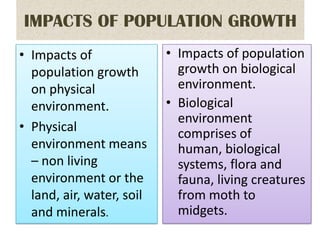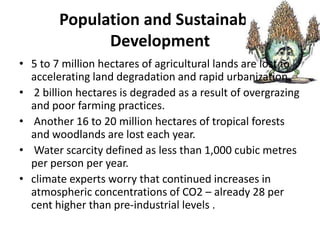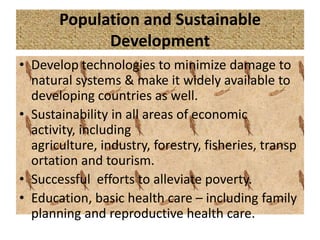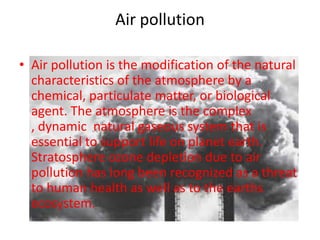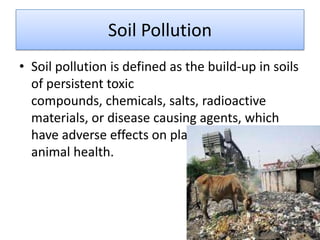Population growth
- 2. IMPACTS OF POPULATION GROWTH • Impacts of • Impacts of population population growth growth on biological on physical environment. environment. • Biological environment • Physical comprises of environment means human, biological – non living systems, flora and environment or the fauna, living creatures land, air, water, soil from moth to and minerals. midgets.
- 3. Impacts on physical environment Most critical resources for human life. Population Growth Utilization + Overuse + Misuse of physical resources Includes impacts on fresh water, owen valleys, waste management, allocation of resources, changing of consumption pattern, rising demand for energy etc
- 4. Impacts on biological environment • The biological components are bound to suffer the consequences. • Natural processes have been altered seriously that have caused serious imbalances in ecosystems. • Includes impacts on destruction of habitats, water crisis, Generalization of waste, endangerment to species, health condition etc
- 5. Population and Sustainable Development • 5 to 7 million hectares of agricultural lands are lost to accelerating land degradation and rapid urbanization. • 2 billion hectares is degraded as a result of overgrazing and poor farming practices. • Another 16 to 20 million hectares of tropical forests and woodlands are lost each year. • Water scarcity defined as less than 1,000 cubic metres per person per year. • climate experts worry that continued increases in atmospheric concentrations of CO2 – already 28 per cent higher than pre-industrial levels .
- 6. Population and Sustainable Development • Develop technologies to minimize damage to natural systems & make it widely available to developing countries as well. • Sustainability in all areas of economic activity, including agriculture, industry, forestry, fisheries, transp ortation and tourism. • Successful efforts to alleviate poverty. • Education, basic health care – including family planning and reproductive health care.
- 7. Pollution Pollution is the introduction by man into the environment of contaminants that contains harmful substances
- 8. Air pollution • Air pollution is the modification of the natural characteristics of the atmosphere by a chemical, particulate matter, or biological agent. The atmosphere is the complex , dynamic natural gaseous system that is essential to support life on planet earth. Stratosphere ozone depletion due to air pollution has long been recognized as a threat to human health as well as to the earths ecosystem.
- 9. Water pollution • Water pollution is the large set of adverse effect upon water bodies such as lakes, rivers, oceans, and groundwater caused by human activities.
- 10. Noise pollution • Noise pollution is displeasing human or machine created sound that disrupts the activity or happiness of human or animal life. • A common form of noise pollution is from transportation, especially from motor vehicles.
- 11. Causes and effects of noise pollution • No one on earth can escape the sounds of noise- an unwanted, disturbing sound that causes in the eye of beholder. • Noise is the disturbance to the human environment that is escalating at such a high rate that it will become major threat to the quality of human lives.
- 12. Soil Pollution • Soil pollution is defined as the build-up in soils of persistent toxic compounds, chemicals, salts, radioactive materials, or disease causing agents, which have adverse effects on plant growth and animal health.

